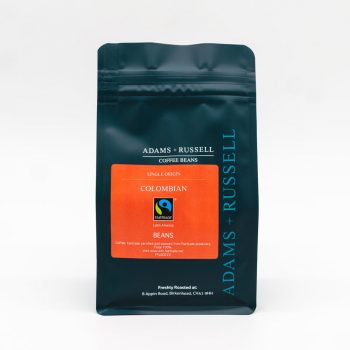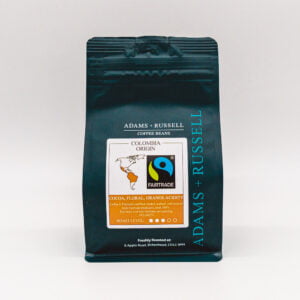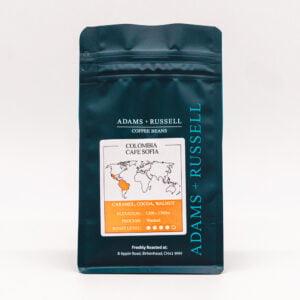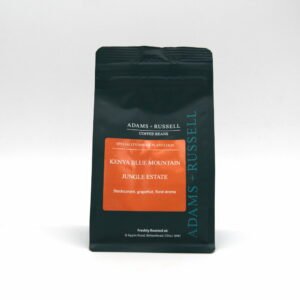The farms & flavours of Colombian coffee beans
- Updated on: March 7, 2024
- Written by: Aimee Bennett
Aimee is a coffee enthusiast and has worked in the coffee industry for years. She sources coffee beans from around the world and her coffee journey began in… (read more).

Coffee flavours, aromas and preparation options differ quite significantly in different countries and regions around the world.
While most of the world’s crop is grown in a region known as the ‘coffee belt’, this is actually a huge area that stretches across multiple continents and countries.
In each of those countries the local climate, ecosystem, soil conditions and altitude of the plantation can affect the flavour and characteristics of the coffee, as well as the plant type and heritage of the plantation.
And that’s all before the beans are harvested, prepared, roasted, blended and made into drinks!
With all of these factors at play, it helps to know a little bit about the range of products from different countries so you can choose your favourite.
Plus it’s always nice to know more about what you’re drinking!
In this article we take a look at what makes coffee beans from Colombia so special and different from those of other countries. We’ll also discuss Colombia itself and why a ‘cup of joe’ from the country is so important to its people.
Featured Products
-
Colombia Origin
- £7.00 – £95.00
- Select options
-
Colombia Cafe Sofia
- £7.00 – £18.00
- Select options
What does Colombian coffee taste like?
Let’s face it, the main thing we usually look for in any cup of coffee is a great taste, and Colombian coffee products are a favourite of drinkers all around the world.
In general, coffee made from beans sourced from plantations in Colombia has quite a mild flavour and is usually very well-balanced making it easy to drink and enjoy.
As an arabica bean it most often has a sweeter and lighter taste than coffee from other sources and this makes it very versatile so it can be prepared in different ways and also paired with lots of different foods or other ingredients.
The caffeine level is also on the lower side compared to most coffees (both other single origin coffees and blends), so it can be enjoyed in many different settings quite easily.
It gives off a sweet, caramel- or cocoa-scented aroma and the acidity level is usually medium to high, giving off citric notes. Some varieties also include hints of red berries or apple at times.
It is also a popular constituent in various blends and can also be roasted to quite a dark level without turning very bitter – so it is very suited for espresso-based drinks.
The main coffee tree varieties grown in the country are Caturra, Typica, Bourbon and Maragogype and the beans are usually grown at around 1,200-2,000 metres above sea level, with the majority of the crop harvested between September and December.
The beans are also very forgiving in almost any roast, which gives coffee-makers the freedom to prepare the drink in any way they prefer.
But of course, that’s all just detail about the coffee itself – part of what makes single origin coffees like Colombian so special is the history and story of the country itself.
About the nation of Colombia
The South American country of the Republic of Colombia is home to around 48 million people in total and is about 5 times the size of the UK.
It is situated in the north of the continent and has land borders with Panama, Ecuador, Venezuela, Brazil and Peru, which are each all coffee-producing nations to some extent.
Colombia is the second largest coffee producer in the world, following Brazil, and exports an average of 11.5 million bags per year. This high volume of production means that the products are often very reasonably priced and is another reason, along with their mild and well-balanced flavour, why they are so often used in blends.
In fact, Colombia is actually the largest global producer of arabica beans, the most popular kind of beans in the world, and the chances are quite high that you have come across coffee beans from the country in a café or restaurant, either in their pure form or as part of a blend.
Colombia has a wide range of different kinds of landscape including mountains, plains, islands and coastlines, as well as humid jungle areas surrounding the mighty Amazon river.
This variety makes Colombia the second most biodiverse country in the world (following Brazil) as well as being the only South American country that has a coast on both the Pacific and Atlantic Oceans.
The country also has a rich human history with evidence of settlements and people from several thousand years ago found across the country.
A globally-recognised and protected brand
Colombian coffee is a well-known and very recognisable source of high-quality beans all around the world
This is reflected not only in its commercial success but also in some of the internationally-recognised statuses that beans sourced from the region have achieved.
For example, the Colombian coffee fields have had a protected designation of origin status by the European Union (EU) since 2007 which protects the brand from imitation and copyright issues.
This means that the EU has determined that coffee from Colombia has a unique taste, identity and other properties because of where it is grown.
In addition, the “Coffee Cultural Landscape” in the country was designated as a World Heritage Site by UNESCO in 2011.
UNESCO World Heritage Sites status is only given to places around the world that are unique, important and of exceptional value, so this is really a recognition of the fantastic quality that Colombian producers provide every year.
You can read more about the different UNESCO criteria used to determine what makes a World Heritage Site here.
Where does Colombian coffee come from?
The majority of the Colombian coffee crop is produced in a region that is usually called the coffee growing axis (Eje Cafetero in Spanish) or the coffee triangle (Triángulo del Café in Spanish).
The area is located in the Paisa region and consists of three ‘departments;’ Quindío, Caldas and Risaralda.
Although the coffee growing axis covers only around 1.2% of Colombia’s land, it is home to tens of thousands of producers including many small, family-owned farms.
These plantations operate at a variety of altitudes and with different local flora and fauna which can all affect the taste, strength and quality of the crop.
An umbrella organisation called the National Federation of Coffee Growers of Colombia represents many of these businesses both at home and internationally.
Among their roles is the protection of Colombia’s single origin brand identity, discussed in more detail above.
More than a drink
Although one of the country’s major export products, coffee in Colombia is also very important for other reasons.
The country has had a difficult past for and has suffered through several decades of internal armed conflict between the government, left-wing guerrilla groups and other factions.
The largest of these was known as the Fuerzas Armadas Revolucionarias de Colombia, or FARC for short, which signed a peace agreement with the government in 2016.
Since then former FARC members have been employed in the coffee industry, re-training as baristas or as farmers in places such as the Tecnicafe coffee technology park.
This is just one example of how coffee is so central to Colombia’s identity on the global stage and one of the many reasons why you should give it a try next time you’re looking for a new coffee flavour!







